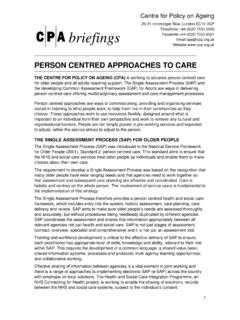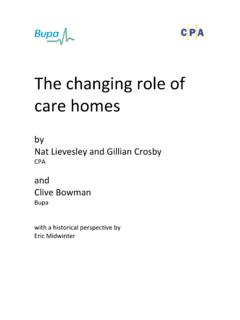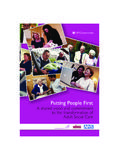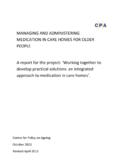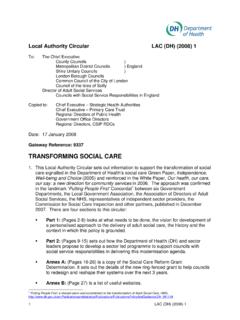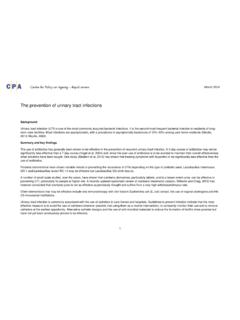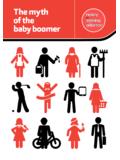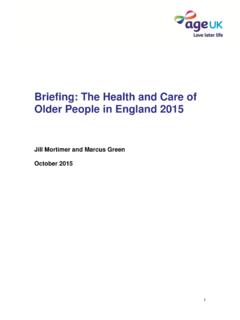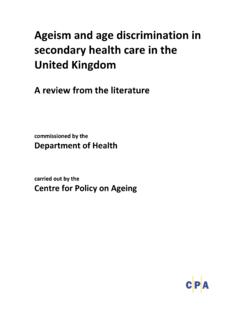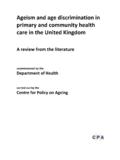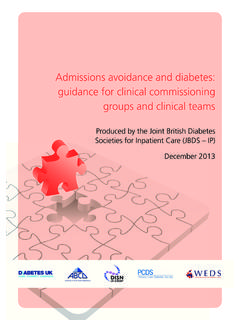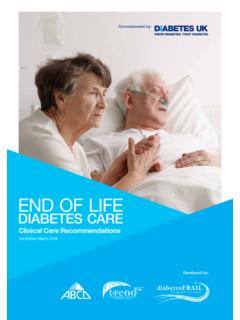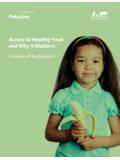Transcription of A of in Bupa care homes: results the census
1 CPA Report A profile of residents in bupa care homes: results from the 2012 bupa census November 2012 Centre for Policy on Ageing The Centre for Policy on Ageing, established in 1947 by the Nuffield Foundation, has a long and distinguished record as an independent charity promoting the interests of older people through research, policy analysis and the dissemination of information. The Centre aims to raise awareness of issues around ageing, influence the development of policies to enable older people to live their lives as they choose, and to support good practice.
2 CPA's overarching focus since its inception has been on empowering older people to shape their own lives and the services they receive. The fundamental touchstone of its approach is to discover and advocate what older people themselves want and need. Centre for Policy on Ageing 28 Great Tower Street London EC3R 5AT Tel: 0207 553 6500 Fax: 0207 553 6501 Email: Web: Summary profile Women still form the overwhelming majority (68%) of bupa care home residents but the proportion is declining with the majority of residents aged under 65 being male. The great majority of bupa care home residents are older people with residents aged 65 and over making up 93% of the care home population in the UK, 95% in New Zealand, 96% in Australia and 97% in Spain.
3 Male residents are younger on average than female residents and, in the UK, 3 years younger on average than they were in the 2009 census . Average (median) length of stay to date' data for 2012 has shown no change or an increase for all countries when compared with 2009. This may indicate a reversal or slowing of earlier trends towards shorter lengths of stay. Over 90% of bupa care home residents are either Frail Elderly' or receiving Dementia care ' and over 90% are receiving Long Term care '. In the UK, while Long Term care ' residents have stayed for 22 months to date, on average, short stay residents stay for less than 3 months.
4 Type of care varies considerably with the age of the resident . Frail Elderly' make up 70% of residents age 95 and over while Dementia care ' peaks for the 75 84 age group. Fifty eight percent of bupa care home residents have a mental or neurological disorder but the overall prevalence declines with age from nearly 70% of under 65s to a little over 40% of residents aged 95 and over. The proportion of residents with dementia continues to rise with, overall 48% of residents either categorised as receiving Dementia care ' or with dementia as a reason for admittance.
5 This peaks at 65% for Scotland. Recorded depression has held steady or fallen for residents of all ages and is below community levels, especially for the older age groups. The prevalence of stroke continues to decline but, at 16% for the UK, is more than three times that in Spain. Diabetes is relatively more common in the UK than in other countries when compared with rates of other non neurological conditions and has a higher prevalence among younger residents. This may herald a greater challenge in the management of this condition in UK care homes in the future.
6 Levels of urinary only incontinence are lower in the UK than in other countries and continue to decline, perhaps providing a marker of good management. Levels of dual incontinence are however more than 10 percentage points higher in the UK than for other countries. Eighty seven percent of bupa care home residents in the UK have high support needs' but this proportion has fallen slightly since 2009 in the UK and all other countries. Twenty eight percent of bupa care home residents exhibit challenging behaviour. This percentage has risen, since 2009, for all countries and for most key triggers.
7 Challenging behaviour is most prevalent in Australia, New Zealand and Scotland. 3 Introduction bupa has carried out a census of the population of its care homes in the UK, New Zealand, Australia and Spain in 2009 and 2012. A similar census of bupa UK homes was carried out in 2003 and of bupa and non bupa UK care homes in 2006. The Centre for Policy on Ageing has been asked by bupa , for the 2012 census , to update its analysis of the profile of bupa care home residents from the 2009 census published in Lievesley, Crosby, Bowman and Midwinter, The Changing Role of care Homes, 2011.
8 This report will complement separate analyses carried out by Abies, focusing on the wellbeing of residents using data on HowRU and HowRwe scores gathered for the first time in the 2012 census . Comparability with the bupa 2009 census The bupa census data collection for 2012 was carried out in a different way from that for the 2009 census . In 2012, to facilitate the collection and processing of data, staff were asked to make marks in optically readable boxes on the census questionnaire. This meant recording age group rather than age and the year and month of admission for recent years only, rather than the actual date of admission.
9 In 2009 data had been collected on the age of the resident , the date of admission and the date on which the census was taken. The 2012 census was carried out mainly in June 2012 but with some over run unto July. The date on which the data was actually collected was not recorded. In 2012 the classification into residential' or nursing' care was not recorded but a wealth of additional information on the wellbeing of residents and the views of residents and visitors, including HowRU and HowRwe scores was collected. For the UK, individual homes codes allow regional and other analysis.
10 bupa care homes in the UK vary tremendously in size from a number with fewer than 20 respondents to one care home with nearly 200. (Figure 1) Figure 1 4 Gender Although the vast majority of bupa care home residents continue to be female, since 2009 this proportion has fallen in every country (Table 1) Table 1 Country Percentage Female 2009 2012 Australia New Zealand Spain UK Because of their shorter life expectancy, male residents are more predominant in the younger age groups than in the older age groups (Table 2 Table 5), forming a majority of the under 65s in Australia and New Zealand.
